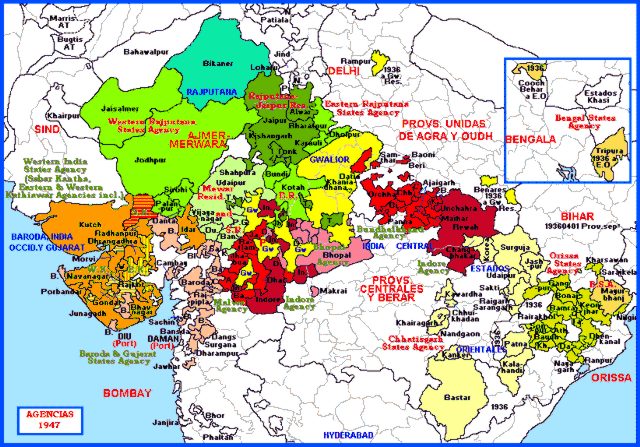This is seventh post looking at the distribution of communities, namely the Khanzada and Meo, that were gazetted as agriculturalist in census of 1901 in the Punjab province. In this post, I will also look at the distribution of both communities in Rajputana and the United Provinces as well. Both groups were entirely Muslim. The Meo and Khanzada were concentrated in the Mewat region, in what is now south east Haryana and north east Rajasthan and claimed a Rajput status. Both groups claimed a similar origin from the Jadaun clan of Rajputs. The Meo and Khanzada were also found in Alwar and Bharatpur states in what was then the Rajputana Agency. In UP, the Meo were found largely in two regions, Rohilkhand, and the Doab region of western UP. Most of the Meo in UP were called themselves Mewati. The total Meo population in 1901 was 374,923, of which 147,198 (39%) were found in Punjab, 168,596 (45%) were found Rajputana (modern Rajasthan) and the remainder 59,129 (16%) were found in UP. In Punjab in 1901, Meo formed 0.7% of the total population of undivided Punjab, and 1.4% of the total Muslim population. They were the 18th largest Muslim caste in the province. The 1931 Census, the last that counted caste, the Meo population in Punjab had fallen to 133,091, and in Delhi which was now a seperate province, the Meo population was 5,259. The 1931 Census did not count the Khanzadas.
I would also ask the leader to look at my post on the Khanzadas to get some background information on the tribe.

Map of Rajputana Agency: Source Wikipedia
Meo of Punjab
Most of the Meo population was concentrated as I have said in the introduction in the Mewat region, roughly the eastern portion of Gurgaon, and southern bits of Delhi. Outside these areas in Hissar and Karnal, there were a few isolated villages of the Meo. In 1901, this region was home to 137,028 Meo, which 93% of their total population in Punjab. In Gurgaon, the Meo formed 17.3% of the total population of the district, and in Delhi 1.2% of the total population.
The Meo of Dera Ghazi Khan
The Meo of Dera Ghazi Khan had separated from the main body of the Meo through a migration in the 16th Century. Most of the Meo of this region considered themselves as Jat, and were Seraiki speaking. They had lost all contact with the main body of the Meo.
Meo Population of Punjab
| District | Population |
| Gurgaon | 128,760 |
| Delhi |
8,268 |
| Firuzpur | 4,378 |
| Jalandhar | 1,385 |
| Dera Ghazi Khan | 880 |
| Karnal | 813 |
| Ambala | 580 |
| Hissar | 543 |
| Other Districts | 1,591 |
| Total Population | 147,198 |
Meo Population of Rajputana
| District | Population |
| Alwar State | 113,154 |
| Bharatpur State |
51,546 |
| Kotah State | 1,072 |
| Marwar (Jodhpur State) | 1,000 |
| Jaipur State | 654 |
| Mewar (Udaipur State) | 559 |
| Tonk State | 208 |
| Jhalawar | 125 |
| Other States and Agencies | 278 |
| Total Population | 168,596 |
Meo Population of the United Provinces
| District | Population |
| Bulandshahr | 9,840 |
| Bareilly | 9,374 |
| Rampur State | 7,356 |
| Aligarh | 6,557 |
| Meerut | 5,184 |
| Mathura | 3,813 |
| Pilibhit | 3,262 |
| Moradabad | 2,513 |
| Nainital | 2,106 |
| Etah | 1,793 |
| Lakhimpur Kheri | 1,217 |
| Badaun | 1,081 |
| Agra | 873 |
| Muzaffarnagar | 779 |
| Etawah | 603 |
| Shahjahanpur | 534 |
| Lucknow | 418 |
| Bijnor | 365 |
| Rae Bareli | 355 |
| Unao | 253 |
| Barabanki | 220 |
| Farrukhabad | 216 |
| Sahanranpur | 210 |
| Sultanpur | 207 |
| Total Population | 59,129 |
Khanzada Population of Punjab
Almost all the Khanzada were found in Gurgaon, where in 1901, they owned nine villages near town of Nuh and to the north of Firozpur.
| District | Population |
| Gurgaon | 3,901 |
| Other Districts | 70 |
| Total Population | 3,971 |
Khanzada Population of Rajputana
| District | Population |
| Alwar State | 8,503 |
| Bharatpur State | 814 |
| Jaipur State | 97 |
| Other States and Agencies | 540 |
| Total Population | 9,954 |